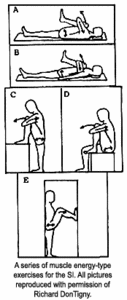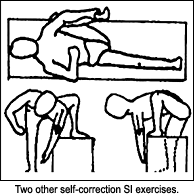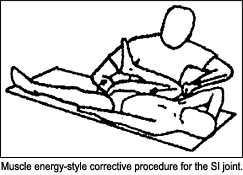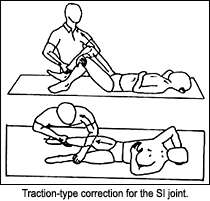So many of our patients have chronic sacroiliac dysfunction. I have written several times about this problem, from several perspectives. This article will describe the work of Richard DonTigny, a physical therapist from Havre, Mont.
Many of our low back pain patients return to the office with a recurrence of posterior or anterior innominate pattern: iliums rotated in the sagittal plane. Especially when this malalignment is associated with sacroiliac joint tenderness and other indicators of sacroiliac dysfunction, it tells us the joint is not functioning properly.
DonTigny's basic indicator is tenderness. He checks the medial aspect of the upper PSIS, the medial aspect of the ilium at the S3 level, and the PIIS. When one or more of these are tender, he feels the SI is involved. He also notes leg length, and tests whether his procedures shorten the leg after correction.
 How can you and your patient help stabilize this joint? One basic tool is enhancing abdominal tone, particularly of the transverse abs, pelvic floor and multifidi. Another is to use cross-frictional massage or Graston Technique to break up adhesions and initiate first-stage healing in the ligaments and tendons surrounding the joint. (I addressed this at length in DC previously; please see www.chiroweb.com/archives/23/14/10.html). What else can the patients do themselves? DonTigny has developed a series of simple exercises that reset the joint. If the unstable patient will correct their own SI alignment daily, or (better yet) several times a day, they will tend to "hold the adjustment" much better.
How can you and your patient help stabilize this joint? One basic tool is enhancing abdominal tone, particularly of the transverse abs, pelvic floor and multifidi. Another is to use cross-frictional massage or Graston Technique to break up adhesions and initiate first-stage healing in the ligaments and tendons surrounding the joint. (I addressed this at length in DC previously; please see www.chiroweb.com/archives/23/14/10.html). What else can the patients do themselves? DonTigny has developed a series of simple exercises that reset the joint. If the unstable patient will correct their own SI alignment daily, or (better yet) several times a day, they will tend to "hold the adjustment" much better.
Sacroiliac Self-Correction Exercises
What are the basic exercises that reset the SI? The first one will look familiar to those of you familiar with post-isometric relaxation or muscle energy technique. I have reproduced a whole series of pictures, showing different positions in which to do the same basic exercise. The basic routine is to have the patient bring the leg up to the chest, grasp the leg with both arms, and push outward with the leg against resistance. DonTigny recommends pushing outward hard for five to 10 seconds, then alternating legs, doing each side three to five times. Note that this can be done supine, sitting, standing using a chair, or in a doorway.
 The second type of exercise is performed supine, with one knee bent, pushing the knee directly along the line of the femur. As you do this, the pelvis will lift on that side, slightly off the surface. You can get a little better motion into the pelvis by wrapping a long belt or strap around the knee, and pushing the knee into the strap (not pictured). Note the sagittal plane torque this is trying to produce in the pelvis. Do this three times on each side, holding for five to 10 seconds at the top. I find that on the involved side, it will feel much stiffer, and it is harder to lift the pelvis freely.
The second type of exercise is performed supine, with one knee bent, pushing the knee directly along the line of the femur. As you do this, the pelvis will lift on that side, slightly off the surface. You can get a little better motion into the pelvis by wrapping a long belt or strap around the knee, and pushing the knee into the strap (not pictured). Note the sagittal plane torque this is trying to produce in the pelvis. Do this three times on each side, holding for five to 10 seconds at the top. I find that on the involved side, it will feel much stiffer, and it is harder to lift the pelvis freely.
 The third set of exercises involves flexing the hip as far as you can, simultaneously pulling it out to the side of the body. A second variation of this is done using a chair or bench and bending forward on the bent- leg side. I would have patients who have possible disc issues, especially those sensitive to flexion, be careful with these by keeping the spine in neutral, or avoiding these exercises altogether.
The third set of exercises involves flexing the hip as far as you can, simultaneously pulling it out to the side of the body. A second variation of this is done using a chair or bench and bending forward on the bent- leg side. I would have patients who have possible disc issues, especially those sensitive to flexion, be careful with these by keeping the spine in neutral, or avoiding these exercises altogether.
Sacroiliac Correction Mobilization
The other aspect of this work is the mobilization. It is done bilaterally, which is counterintuitive for me. The basic idea is to bring the ilium into flexion and to mobilize the joint. This procedure should correct leg length discrepancy. DonTigny assumes the leg is too long, due to anterior rotation, and looks for shortening of the leg on correction. He alternates sides on the procedure, and continues until the leg length no longer changes.
 The first procedure is a lot like the first set of exercises. With the patient supine, bring one of their legs, bent at the knee, up toward their chest. Have them push toward you; they are trying to extend at the hip as you resist. It is isometric: Don't let them move the hip more than a centimeter or two. Hold for five seconds. Switch to the other side and repeat. Continue until the leg length no longer changes, which may take three to five repetitions on each side.
The first procedure is a lot like the first set of exercises. With the patient supine, bring one of their legs, bent at the knee, up toward their chest. Have them push toward you; they are trying to extend at the hip as you resist. It is isometric: Don't let them move the hip more than a centimeter or two. Hold for five seconds. Switch to the other side and repeat. Continue until the leg length no longer changes, which may take three to five repetitions on each side.
The second procedure (pictured above right) involves distracting the bent leg. The picture shows it well. Use your own body weight, shifting laterally, as well as the fulcrum of your arms. This will usually feel great to the patient. It will feel quite "stuck" on the more involved side, and you should feel the movement improve as you do the procedure. Again, perform it three times on each side, alternating sides, holding the traction for about 10 seconds. This traction mobilization has been a wonderful addition to my toolbox.
 I recognize this is a different model of the SI than most of us use. I recommend you read DonTingny's articles for a deeper understanding of his view of the biomechanics and pathomechanics of the SI joint. You could use your usual indicators of leg length, tenderness of the SI joint, and restriction of the joint to determine what is "off" at the beginning, use these procedures to correct, and then see whether these procedures have completely corrected your indicators. Keep an open mind - this is probably nothing like what you usually do to correct the SI joint. I have found these procedures quite effective for selected patients. These techniques seem to work best for the patient with an anterior rotated ilium, found usually on the right, when the right SI also is fixated.
I recognize this is a different model of the SI than most of us use. I recommend you read DonTingny's articles for a deeper understanding of his view of the biomechanics and pathomechanics of the SI joint. You could use your usual indicators of leg length, tenderness of the SI joint, and restriction of the joint to determine what is "off" at the beginning, use these procedures to correct, and then see whether these procedures have completely corrected your indicators. Keep an open mind - this is probably nothing like what you usually do to correct the SI joint. I have found these procedures quite effective for selected patients. These techniques seem to work best for the patient with an anterior rotated ilium, found usually on the right, when the right SI also is fixated.
Resources
- The DonTigny Low Back Pain Management Program (a patient handout): www.kalindra.com/rounds.pdf.
- DonTigny RL. Critical analysis of the sequence and extent of the result of the pathological failure of the self-bracing of the SI Joint. Journal of Manual and Manipulative Therapy 1999;7:173-181. www.kalindra.com/critical.pdf.
- www.kalindra.com/sacroiliac.htm (a fascinating site for sacroiliac articles).
Click here for more information about Marc Heller, DC.





